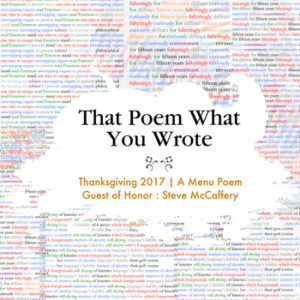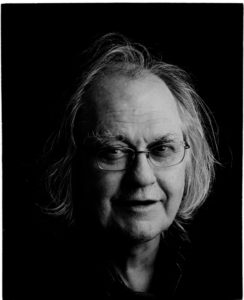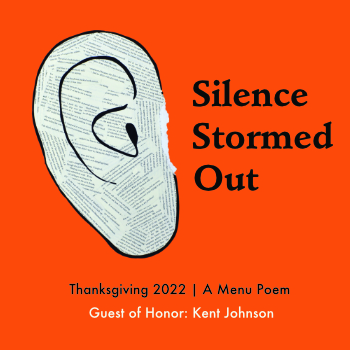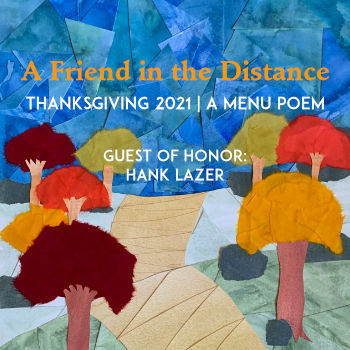Happy Thanksgiving
A Menu Poem by Geoffrey Gatza
That Poem What You Wrote
Guest of Honor : Steve McCaffery
Thanksgiving Introduction

Hello and welcome to the 2017 Thanksgiving menu poem. This is the sixteenth incarnation of the Thanksgiving Menu-Poem! Our guest of honor is the wonderful Steve McCaffery. This series began in 2002 with a Menu-Poem to honor Charles Bernstein, and since then this series engages Thanksgiving as the basis to celebrate poetry, poets and the poetry community. Being a trained professional chef I have blended my love of food and poetry into a book-length work as a feast of words to bring everyone a tiny bit closer together.
This project is a conceptual meal served for the thousands of friends I would love to have over to our home on Thanksgiving Day. Since it is unavoidably impossible to even consider doing such a thing in real life, I have designed a menu of foodstuffs that reflect upon the guest of honor as a person, a poet and their poetry. These works directly respond to our surrounding environment and uses everyday experiences as a starting point. Often these are framed instances that would go unnoticed in their original context. With a conceptual approach, this menu-poem tries to increase the dynamic between audience and author by objectifying emotions and investigating the duality that develops through different interpretations.
This year our guest of honor is Steve McCaffery. This poem series represents a combination of sound and visual poetries as a tribute to the magnificent works he has created. This is his seventieth year and to celebrate this milestone mark in his life this year’s Thanksgiving menu is an extravagant affair. Since Steve was born in England, a traditional American Thanksgiving dinner would be a nice choice to celebrate but maybe not the best choice. Steve is very much a gourmand and since this feast is conceptual and our budget is imaginary I decided to make this an expensive, luxurious event. Included in this dinner are champagnes, caviar, fois gras, white truffles from Alba, jamón Ibérico, rare vintage wines, Armagnac and to top it all off we finish with a 50 year old whisky that retails for twenty five thousand dollars a bottle. I am sure you will agree that Steve deserves no less.
I hope you enjoy this meal, the menu and the poem. Have a Happy Thanksgiving!
Rockets, Geoffrey
Bio, Interesting Links and Poems

Steve McCaffery was born in Sheffield, England, and earned a BA in English and philosophy from Hull University (England), an MA from York University (Toronto), and a PhD from the program in poetics, English, and comparative literature at SUNY Buffalo.
A critic, poet, and professor, McCaffery was part of the Canadian avant-garde poetry scene in the 1970s. His creative work has been marked by innovation and a move away from conventionally narrative forms. His oeuvre includes sound poetry (as part of the collaborative group the Four Horsemen with poets Rafael Barreto-Rivera, Paul Dutton, and bpNichol) and concrete poetry. His visual poetry is in permanent collections at the National Gallery of Canada in Ottawa, the Paul Getty Research Institute in Malibu, the International Concrete Poetry Archive in Oxford, England, and the New York Public Library in New York City.
McCaffery’s poetry publications include a number of chapbooks and full-length collections, among them Modern Reading: Poems 1969–1990 (1991), Seven Pages Missing: Selected Texts Volume One (2001) and Volume Two (2002), and Verse and Worse: Selected and New Poems of Steve McCaffery 1989–2009 (2010). He has twice received the Gertrude Stein Award for Innovative North American Poetry.
McCaffrey and bpNichol edited Sound Poetry: A Catalogue (1978) and Rational Geomancy: The Kids of the Book-Machine: The Collected Research Reports of the Toronto Research Group 1973-1982 (1992), a manifesto and sampling of Canadian arts and writing. His published scholarly works include Imagining Language with Jed Rasula (1998), North of Intention: Critical Writings 1973–1986 (1986), and Prior to Meaning: The Protosemantic and Poetics (2001).
McCaffery is a professor in the Poetics Program at SUNY Buffalo.
From The Poetry Foundation
Interesting Links
Poems by Steve McCaffery:
Note on the Poem:
“The art of change ringing is peculiar to the English, and, like most English peculiarities, unintelligible to the rest of the world. To the musical Belgian, for example, it appears that the proper thing to do with a carefully tuned ring of bells is to play a tune upon it. By the English campanologist … the proper use of the bells is to work out mathematical permutations and combinations.”
—Dorothy L. Sayers, The Nine Tailors
My love of change ringing came about many years ago, when I first read Dorothy L. Sayers Lord Peter Wimsey novel, The Nine Tailors. The basis of the detectives hunt revolved around a message encoded in the changes in a peal, a three hour long series of bell ringing containing 5,000 or more changes without breaks or repeating a row. I would listen to Bells on Sunday on BBC Radio 4. In the short burst of church bells I began to love the sounds, patterns and how they flustered the spirit; and after many years, I began to think on how to use this for poetry.
This poem is one among a long series of poems I have constructed based upon change ringing. This is an English method of ringing church bells to produce a rich cascade of sound set in a predetermined series of order. This order is based on weaving basic sequences of ringing, set in rounds, by moving down the scale of bells. Change ringing produces very different sounds than the hymns and songs played on carillon bells. The bells are hung dead, in a different style of frame allowing the bells to swing through an arc of 360 degrees, to produce a rich sound called a good strike. And unlike hymns or songs, these pieces evolve as they dissolve, open as much as they close in on the ideas initially started by the first line.
The ringing of a set of bells in a precise relationship to one another creates a transcendent sounds upon which one can meditate. The sequencing of the bells are numbered 1, 2, 3, 4, 5… from the highest-pitched bell to deepest ringing bell. After each sequence, or round, the order of the bells is changed slightly in a prearranged way. With 5 bells, there are 5 × 4 × 3 × 2 × 1, or 120, possible changes, which take about 4 minutes to ring. With 6, 7, or 8 bells, the number of unique changes is 720, 5,040, and 40,320, respectively. To produce different variations, bells are made to change places with adjacent bells in the row, for example:
1 2 3 4 5 6 7 8
2 1 4 3 6 5 8 7
These rows are the musical notation of change ringing. No bell moves more than one place in the row at a time, although more than one pair may change in the same row. In order to ring a different row with each pull of the rope, ringers have devised methods for changing pairs in orderly ways. These place changes produce musical patterns, with the sounds of the bells weaving in and out.
The poems in this series of works are set up for performance. They are scored for people in place of bells. These poems range from pieces set for three readers in a plain hunt up to an hour-long quarter pealset for ten readers. The number of performer can range from three people all the way up to twelve. A plain hunt is the simplest method where all the voices hunt in or out, following the idea of odds out evens in, ‘in’ refers to going down to the lead, (the front) the first word is the second, ‘out’ refers to going up to the back and the first bell to reach the back is the fifth. Then they all plain hunt up to the back and down to the front in turn. The first section is set in colors to illustrate how the patterns function and weave in and out. The other sections are set in black text so that the group of performers can find their own way in the pieces.
This poem is based upon the Sheffield Surprise Major, and as such set for eight bells. Thus this poem should have eight voices to perform it fully. This poem is set as a half peal, having 2,520 lines. The book is, unnecessarily, divided into 70 page-length sections that would be conjoined together to fit as one full performance. This was done for several reasons but ease in reading it was the foremost consideration. You can see a diagram of how this poem follows a program of the eight positions below. The significance of the 70 sections is to honor the 70th birthday of our honored guest, Steve McCaffery. Yet this is only one of the many ways in which this poem honors Steve McCaffery. Being a revered sound poet, this style of poem embodies the ethos of his life’s work. The program texts used in place of the bells are language snippets and text clusters taken from poems, essays and other prose pieces written by Steve. The originals are readily available online, mostly from the University at Buffalo’s Electronic Poetry Center and a link is provided below.
How to read these poems on the page is entirely up to the reader. They are based upon the scoring of a series of changes, using the method as a starting point in which to make a poem. There are improvisations, deviations and out-right errors if these viewed by a real Change Ringer. But to that group I offer consolation by saying that this is an entirely different form of art, like a movie is to screenplay as a screenplay to a novel. To the rest of the audience, it is just poetry, enjoy.
Program Texts Used:
Electronic Poetry Center: Steve McCaffery
http://epc.buffalo.edu/authors/mccaffery/
Poems:
· Untitled for RC from RIF/T
· Carnival at Coach House Books
· ATTRITIONS from Deluxe Rubber Chicken
· CORRIGENDA IN TWO STANZAS from Deluxe Rubber Chicken
· NO TITLE PLEASE I’M NOT WELL from Deluxe Rubber Chicken
Essays
· Afterword to Verse and Worse: Selected Poems 1989-2009
· “The Unreadable Text” from Code of Signals pp. 64-99
· “Sound Poetry – A Survey.”
· A Short Conclusion (in memoriam Jackson Mac Low).”
Thanksgiving Menu
ROYAL KALUGA CAVIAR
Red Onion “Gelée” and Pumpkin mousseline
Modicum, Extra Brut, “Schramsberg Vineyards,” Blanc de Blancs, North Coast 2013
LONG ISLAND MOULARD DUCK FOIE GRAS TERRINE
Creamed Royal Trumpet Mushrooms, Satsuma Marmalade
Veuve Clicquot CAVE PRIVÉE ROSÉ 1990
SHAVED WHITE TRUFFLES FROM ALBA
Browned Butter, Toasted Black Rice, Apple Brunoise, Belgian Endive
Prinz, Riesling, “Hallgartener Jungfer,” Kabinett, Rheingau 2009
SEARED DIVER SCALLOP
Jamón Ibérico, Pearl Onions, Garden Radishes, Watercress Leaves
Rebholz, “Vom Muschelkalk,” Pinot Blanc, Trocken, Pfalz, 2009
CHARCOAL GRILLED VENISON
Cardamom Poached Cranberries, Piedmont Hazelnuts, Garden Fennel Purée
Apple-Ginger Mignonette
Opus One Napa Valley Red 2012
CHEESE, SHERRY & ARMAGNAC
Fromager d’Affinois, Manchego, Beecher’s Reserve Cheddar,
Cambozola Black Label, Port Salut & Comte
El Maestro Sierra Oloroso “Extra Viejo” VORS 1/7 Jerez de la Frontera, Sherry
1967 Darroze Domaine Bellair 50 Year Old Vintage Cask Strength Armagnac
DESSERT
Classic Crème Brûlée
with Quince Poached with Star Anise
Roasted Northern Spy Apple
with Maple Ice Cream
Glenfiddich 50 Year Old, Glenfiddich Whisky Distillery, Speyside



Comments (0)